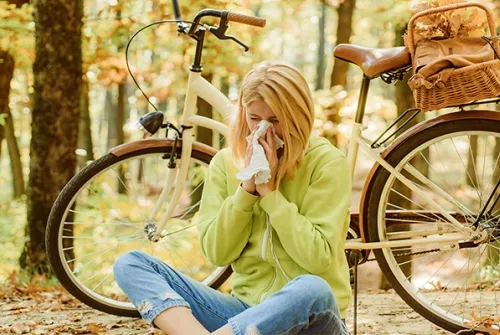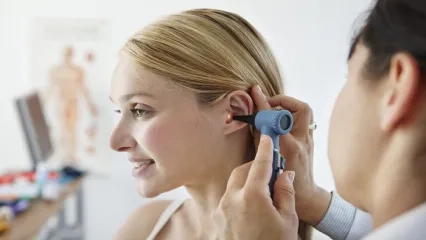Alo Yeditepe
Alo Yeditepe
Don’t Let Allergic Rhinitis Spoil Your Life
Head of Yeditepe University Hospital’s ENT Department, tells Reference readers how to spot and deal with one of the most frequently occurring allergies that may be having a more severe impact on your quality of life than you realize.
With symptoms that include sneezing, runny nose, nasal congestion and teary eyes, allergic rhinitis affects some people all year round while others are affected more severely during the spring months.
Allergies are simply undesired specific immune responses to antigens. Allergic reactions occur either all year round (perennial) or at certain times of year (seasonal) when the sufferer comes into contact with the allergen in question. House dust mites (D.pteronyssinus, farina), fungi (chaetomium globosum, aspergillus, penicillium, mucor), animal allergens (cats, dogs, rodents, birds) are perennial while tree, plant, grass and flower pollen allergens trigger allergies only at certain times of year. Fungi such as alternaria alternarta and cladosporium are also seasonal, as they emit their spores in certain seasons. Of all allergic conditions, allergic rhinitis is the most common and the one that has the greatest affect on sufferers’ noses. It is sometimes accompanied by atopic dermatitis, allergic asthma, and allergic rhinoconjunctivitis. It can also trigger chronic conditions such as sinusitis, pharyngitis, middle ear infection and nasal polyps. The family medical history is important. The sufferer’s personal story and the issue of which irritants he or she has been exposed to, need to be researched carefully.
Caused by technological developments as well as environmental factors, allergens and allergic rhinitis occur with ever greater frequency. The condition has been observed more and more commonly in office workers and those working in a closed space.Carpets, air conditioners, computers, plants, paper products and chemical agents in offices can trigger allergies.
Blood And Skın Tests
The most ideal and effective preventive measure against allergies is simply to avoid the source of the problem. To be able to do this, it is important to undergo blood and skin tests need to determine the allergen. Preventive measures can be taken at home, but clearly not if the allergen is in the open air. Ventilation and conditioning systems can be effective against allergens indoors, especially in the pollen season. HEPA (high-efficiency particulate arresting) filters are much more effective than the fiberglass filters used in most ventilation systems. Therefore it is recommended that you change filters twice a year. Staying indoors when the pollen levels are high during the morning hours and as the sun rises and the temperature heats up can also help.
Fungi and spores, on the other hand, are present throughout the year indoors and outdoors. Their greater intensity also renders air filtering systems less effective. They reach peak levels as the sun sets and the temperature falls in the evening.
Decaying plant material encourages the development of fungi, meaning that allergic reactions can be more severe in the presence of house plants indoors, and in gardens. Other potential sources of fungi are torn paper in bird cages and shoes that are not well aired. The simplest way to prevent mold in your fridge is to illuminate the contents a little, even when the fridge is closed. House dust contains more allergens the longer it has been there. The peak season for house dust allergens is the fall. Dust frequency is in inverse proportion to height. Humidity and warmth increases house dust mite populations. Recommended measures include using special HEPA filter hoovers, acaricides, washing laundry above 60 degrees C, avoiding carpets and curtains, and removing dust-collecting objects.
Medical Treatment
As well as preventive measures, medical treatments are also available. Medical treatment does not cure the sufferer, rather it alleviates symptoms and reduces discomfort during allergic attacks. Medical treatment for allergic rhinitis carried out before the pollen season has a positive impact on the sufferer’s social life. The most effective treatment for allergic rhinitis is immunotherapy. The sufferer is desensitized by being exposed to controlled and progressively increasing doses of the allergen to which they are sensitive. This treatment can be hard for the sufferer to maintain. Yeditepe University Hospital offers sufferers immunotherapy in the form of oral drops against house mites, and tablets against pollen allergies. These treatments take into consideration the importance of ease of use and sustainability for patients, making it easier for them to complete the treatment.
UV rays that are beneficial in atopic dermatitis and other dermatological cases have also been shown to be of use against allergic rhinitis when administered nasally. UV-B (5%) and UV-A (25%) and visible rays (70%) are applied by means of a special device called a Rhinolight.
Allergic rhinitis-caused sinusitis, abnormal concha growth, and nasal polyps, are all surgically treatable at Yeditepe University Hospital. Allergic rhinitis has a negative impact on sufferers’ quality of life and impedes their working and social lives. Early diagnosis, allergy determination, preventive measures and starting treatment all help to prevent the onset of chronic diseases later on in life.
Allergic Rhinitis Symptoms
• Sneezing
• Runny nose and nasal congestion
• Watery eyes and itching
• Coughing and sore throat
• Itchy throat, nose or upper palate
• Sinus pain
• Decreased sense of smell and taste
• Frequent nose scratching
• Fatigue, perception difficulties, sleep disorder
These symptoms are sometimes accompanied by wheezing, coughing and headaches.
This content was prepared by Yeditepe University Hospitals Medical Editorial Board.
”
See Also
- What is Laryngeal Cancer? Symptoms, Risk Factors, and Treatment Methods
- What Are Head and Neck Cancers? Diagnosis and Treatment
- Causes and Treatment of External Ear Inflammation
- What is a Neck Mass?
- Tonsillectomy in Children
- Ear Pain During Flight Can Be a Sign of Some Diseases!
- They Said He Could Never Speak Again Due to Laryngeal Cancer, But Today After the Surgery He Underwent, He Can Speak!
- Pool and Hot Weather Trigger Ear Eczema
- Hearing Health
- Allergic Rhinitis Targets People in Big Cities
- Can Nutritional Defects Underlie Middle Ear Inflammation?
- Stem Cell May Be the Future Cure to Hearing Loss with Bionic Ear as Hope
- Nasal Sprays Can Be Addictive!
- Adenoid and Tonsil Problems in Children
- Nasal Sprays Can Be Addictive
- When Should Adenoid Surgery Be Performed in Children? When Should It Not Be Done?
- Treated For Asthma For Two Years But Has Had A Tumour In Her Trachea
- Treatment without Tampons in Nasal Surgeries
- Chance of Treatment in Patients Who Have a Tube Inserted in Their Throat to Breathe
- Can Infection Cause Permanent Hearing Loss?
- He Was Ashamed to Speak, and He Was Reborn with His New Voice
- Survived from Tumor Covering Half of Larynx With Closed Surgery
- Beware of hoarseness lasting longer than 15 days!
- Throat Infection
- ENT Problems Seen in the Summer
- Nose Bleeding
Alo Yeditepe








